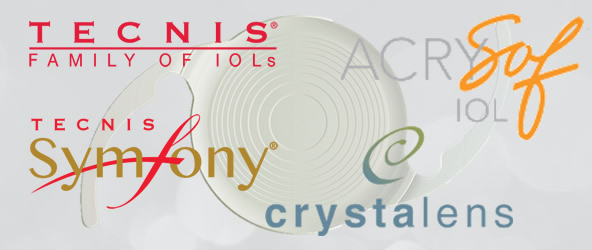Types of Advanced Technology Lens Implants

What is an Advanced Technology IOL?
When a person has cataract surgery, the natural lens in the eye is removed and replaced with a man-made lens (IOL). A cataract is a clouding of the natural lens that occurs with age, and replacing the cloudy lens with a clear lens gives clearer vision. There are many different types of IOLs available. A standard IOL will give clear vision, but generally glasses are still needed to see near and/or far. With Advanced Technology IOLs, also known as Premium IOLs, we can often reduce or eliminate dependence on glasses or contact lenses.
Advanced Technology Lens Implant Options
How do I choose a lens implant type?
Your doctor will perform a complete eye exam to assess the overall health of your eye. Noninvasive, painless measurements of the eye are then performed using state of the art technology. Your doctor will then narrow down the lens implant options that are appropriate for your eye based on the exam and the measurements. You will be asked about the visual needs of your lifestyle and daily activities, as well as your wishes regarding independence from glasses or contacts. Your doctor will use all of this information to help guide you in making the best choice of IOL for your eyes.
Toric Monofocal IOLs
These lens implants correct astigmatism in the patient’s eye. Many people have a cornea that is not perfectly spherical in shape. This asymmetric curvature is called astigmatism. Astigmatism can be corrected in glasses, contact lenses, or in the eye itself with a Toric IOL. When cataract surgery is performed, measurements before surgery will determine how much astigmatism is in the surface of your eye (the cornea). This may or may not be similar to the amount of astigmatism that is in your pre-surgical glasses or contact lenses. If you have significant astigmatism in your cornea (as determined by measurements of the surface of the eye), and you prefer to be less dependent on glasses/contacts, a Toric Monofocal IOL will correct the astigmatism and provide clear vision at either distance or near. Toric Monofocal IOLs are not multifocal IOLs, so they have to be set for a particular type of vision without glasses (near vision or distance vision clear without glasses).
Sometimes a patient chooses to have Toric Monofocal IOLs with one eye set for near and the other set for distance. This is called Monovision. Monovision can provide independence from glasses for many activities. While not the best choice for all patients, it can be an excellent choice for patients who have liked monovision in contact lenses in the past.
Toric Multifocal IOLs are another option for patients with astigmatism. These IOLs provide better vision without glasses for both near and far, and also correct astigmatism. Please see below under Multifocal IOLs.
Trifocal IOLs (PanOptix®)
The PanOptix® Trifocal is a type of multifocal IOL. It is designed to provide distance, intermediate (computer), and near (reading) vision. Like other multifocal IOLs, it is designed with multiple rings of different power (unlike trifocal glasses). This IOL is available with astigmatism correction as well (Toric PanOptix® Trifocal Lens). The full benefit of this IOL is seen when it is placed in both eyes. All multifocals can cause some glare, halos, or a mild decrease in contrast sensitivity, but these are generally mild and overall patient satisfaction with this lens is excellent. While we can’t guarantee independence from glasses with any IOL, most of our patients do not need glasses most of the time with these IOLs.
Multifocal IOLs
These lenses generally provide good uncorrected near, intermediate, and distance vision. With this type of IOL in both eyes, a patient usually does not need glasses most of the time. Multifocal IOLs can also correct astigmatism (Toric Multifocal IOLs). All multifocal IOLs can cause some glare, halos, or a mild decrease in contrast sensitivity, but these are generally mild and overall patient satisfaction with these lenses is excellent. While we cannot guarantee independence from glasses with any IOL, most of our patients do not need glasses most of the time with this IOL.
Extended Depth of Focus IOLs (Extended Range IOLs)
Extended depth of focus IOLs generally provide good distance and intermediate (computer) range vision. Glasses are generally still needed for reading. They can also correct astigmatism (Toric Extended Depth of Focus IOLs). They provide more range without glasses than a monofocal IOL, but not as much range as a true multifocal IOL. These lenses are often a good compromise choice for patients who are not ideal candidates for a multifocal IOL. Patients who have macular conditions such as macular degeneration or epiretinal membranes are not good candidates for multifocal IOLs – the results are not as good. If, however, the macular findings are very mild, an extended depth of focus IOL may be a good option. This depends, of course, on a complete exam by the ophthalmologist to determine if the choice is appropriate for the eye.
Accommodating IOLs (Crystalens® IOL)
These lenses also provide near and far vision by flexing and slightly shifting in the eye when you shift from near to far viewing or visa versa. We find these lenses give a better range of focus than a standard IOL, but readers may still be needed for intermediate and near vision. We use this type of IOL for patients who want to have a range of focus but are not good candidates for a multifocal IOL (we don’t recommend the multifocal IOLs in patients with macular disease such as macular degeneration, macular pucker, etc.).
How does an Intraocular Lens (IOL) Work?
An IOL has a prescription built into it, much like the lens in your glasses or contact lens. Special measurements of your eye are taken before surgery to help us determine the power of the IOL needed for your specific eye. The IOL, once in place in the eye, then focuses light on the retina, giving you a clear image.
How Long is Cataract Surgery?
Generally cataract surgery takes about 15-20 minutes. You will usually be at the surgicenter or hospital about 2 to 3 hours. During this time paperwork is filled out, dilating drops are administered, the staff will recheck your medical history, and you will be kept about a half-hour after the procedure to make sure you are feeling well and all of your instructions are clear.
Are there any Risks Associated with Advanced Technology IOL’s?
The general procedure for cataract removal and IOL insertion is the same regardless of the type of lens used, so for the most part the risk is not different. With a Toric IOL or limbal relaxing incisions to correct astigmatism, there is a risk of placing the IOL or the relaxing incision in the wrong position, which could actually increase the astigmatism in the eye. Our practice uses the VERION ™ Image Guided System to allow for the most accurate correction of astigmatism. This system images the eye in the office and then electronically transfers the patient’s unique imaging data to the operating room laser and microscope. This allows for the most precise placement of an astigmatism correcting lens or relaxing incisions. If a Toric IOL rotates, which is very rare and only occurs soon after surgery, it can be repositioned. This could be done in a second trip to the operating room within a couple weeks of surgery if needed to correct such a problem.
With multifocal IOL’s some patients have glare with night driving after surgery. This is generally mild and tends to dissipate over several months. Even when patients have some glare, most feel that the benefits of this lens allowing them to see near and far without glasses outweighs the mild glare symptoms. There is also a slight loss in contrast sensitivity with multifocal IOLs. Most patients do not notice this.
For more detailed information on cataracts, cataract surgery, and different types of lens implants please select a topic below:

